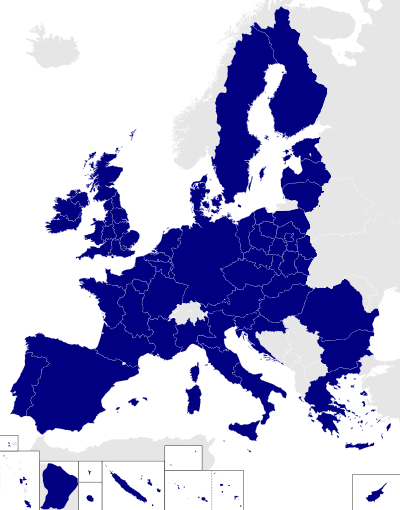Directive (European Union)
| European Union |
 This article is part of a series on the |
Policies and issues
|
A directive is a legal act of the European Union,[1] which requires member states to achieve a particular result without dictating the means of achieving that result. It can be distinguished from regulations which are self-executing and do not require any implementing measures. Directives normally leave member states with a certain amount of leeway as to the exact rules to be adopted. Directives can be adopted by means of a variety of legislative procedures depending on their subject matter.
Legal basis
The legal basis for the enactment of directives is Article 288 of the Treaty on the Functioning of the European Union (formerly Article 249 TEC).
Article 288To exercise the Union's competences, the institutions shall adopt regulations, directives, decisions, recommendations and opinions.
A regulation shall have general application. It shall be binding in its entirety and directly applicable in all Member States.
A directive shall be binding, as to the result to be achieved, upon each Member State to which it is addressed, but shall leave to the national authorities the choice of form and methods.
A decision shall be binding in its entirety upon those to whom it is addressed.
Recommendations and opinions shall have no binding force.
The Council can delegate legislative authority to the Commission and, depending on the area and the appropriate legislative procedure, both institutions can seek to make laws.[2] There are Council regulations and Commission regulations. Article 288 does not clearly distinguish between legislative acts and administrative acts, as is normally done in national legal systems.[3]
Creation of a directive
The text of a draft directive (if subject to the co-decision process, as contentious matters usually are) is prepared by the Commission after consultation with its own and national experts. The draft is presented to the Parliament and the Council—composed of relevant ministers of member governments, initially for evaluation and comment, then subsequently for approval or rejection.
Legal effect
Directives are binding only on the member states to whom they are addressed, which can be just one member state or a group of them. In general, however, with the exception of directives related to the Common Agricultural Policy, directives are addressed to all member states.
Implementation
When adopted, directives give member states a timetable for the implementation of the intended outcome. Occasionally, the laws of a member state may already comply with this outcome, and the state involved would be required only to keep its laws in place. More commonly, member states are required to make changes to their laws (commonly referred to as transposition) in order for the directive to be implemented correctly. This is done in approximately 99% of the cases.[4] If a member state fails to pass the required national legislation, or if the national legislation does not adequately comply with the requirements of the directive, the European Commission may initiate legal action against the member state in the European Court of Justice. This may also happen when a member state has transposed a directive in theory but has failed to abide by its provisions in practice.
Direct effect
Even though directives were not originally thought to be binding before they were implemented by member states, the European Court of Justice developed the doctrine of direct effect where unimplemented or badly implemented directives can actually have direct legal force. Also, in Francovich v. Italy, the court found that member states could be liable to pay damages to individuals and companies who had been adversely affected by the non-implementation of a directive.
See also
- EudraLex
- EUR-Lex
- European Union regulation
- Framework decision
- Law of the European Union
- List of European Union directives
- Policy measures of the European Union
References
- ↑ European Union law after Maastricht: a practical guide for lawyers outside the common.
The Union has two primary types of legislative acts, directives and regulations
- ↑ Christine Fretten; Vaughne Miller (21 July 2005). "The European Union: a guide to terminology procedures and sources" (pdf). UK House of Commons Library, International Affairs and Defence Section: 8. Standard Note: SN/IA/3689. Retrieved 3 September 2009.
Both the Council of Ministers and the Commission are empowered under the EC Treaty to make laws.
- ↑ Steiner, Josephine; Woods, Lorna; Twigg-Flesner, Christian (2006). EU Law (9th ed.). Oxford: Oxford University Press. pp. 56–60. ISBN 978-0-19-927959-3.
- ↑ "Internal Market Scoreboard: best result ever – Member States reach new target ahead of deadline". Europa (web portal). 9 July 2008. Retrieved 18 January 2009.
External links
- UK House of Commons: Report of the EU Legislative Process and scrutiny by national parliaments.
- EUR-Lex, European Union Law database.
- EU Legislative Procedures

